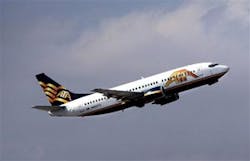ATA Set to Emerge From Bankruptcy
INDIANAPOLIS_ATA Airlines, once the nation's 10th-largest carrier, will emerge from bankruptcy Tuesday as a leaner airline that hopes to lure back passengers - and a profit - by focusing on vacation travel.
The Indianapolis-based airline and parent company ATA Holdings Corp. have scaled back their fleet of jets, slashed destinations and cut by half their labor force since filing for Chapter 11 bankruptcy protection in October 2004.
Only time will show whether ATA will be able to successfully redefine itself as a niche carrier amid turbulent economic times that have forced at least seven airlines into bankruptcy proceedings in the past three years.
"The longer-term issue for ATA is that they have to turn a profit and they have to be consistently profitable or else they won't survive in this business," said Michael Miller, an aviation analyst with Washington, D.C.-based The Velocity Group. "You can't just be a low-cost airline. You have to be a profitable low-cost airline."
ATA's emergence plan - which focuses on such destinations as Cancun, Los Angeles and Las Vegas and includes an increase in military charter business - was approved by a federal bankruptcy judge on Jan. 30.
Airline spokesman Rick Hightower said the carrier's executives were meeting Monday with investors. He declined further comment.
ATA is one of several airlines to exit bankruptcy in the past year. United Airlines emerged on Feb. 1, Hawaiian Airlines left bankruptcy protection in June 2005 and US Airways exited last fall after receiving approval to merge with America West Holdings Corp.
Delta Air Lines Inc. and Northwest Airlines remain under bankruptcy protection.
"I think ATA emerging from bankruptcy is indicative of what has happened and will continue to happen in the airline industry," said Darryl Laddin, an Atlanta bankruptcy attorney who has worked with troubled airlines.
For ATA, which spent more than 420 days under Chapter 11 protection, that has meant cutting routes to more than a dozen cities and ending flights to and from its home base of Indianapolis. The carrier dropped about half its 60 jets and slashed its work force from 7,000 employees to about 3,000 and renegotiated contracts with pilots, flight engineers, flight attendants and technicians.
Founder George Mikelsons retired in August and was replaced by CEO John Denison, a former Southwest Airlines executive who joined ATA in January 2005.
But the keys to ATA's emergence lie in an infusion of capital from the private equity fund MatlinPatterson Global Opportunities Partners II, which agreed to invest up to $120 million, and a partnership with former low-cost rival Southwest Airlines.
Under ATA's "code share" agreement with Dallas-based Southwest, passengers can buy one ticket and fly on either airline on certain routes. The partnership, which began a year ago, generated about $50 million for Southwest in 2005, a Southwest spokeswoman said.
The carrier also must continue to rein in spending.
During the first 11 months of 2005, ATA lost $75.7 million on revenue of $1.02 billion. In November, the airline had nearly $427 million in assets and $1.5 billion in debt, according to federal filings.
Company officials said they plan a slow and steady climb out of bankruptcy. ATA announced in January that it was expanding service to four cities and adding more flights to Hawaii. The airline, which has a hub at Chicago's Midway airport, hopes to get another boost from summer travelers.
